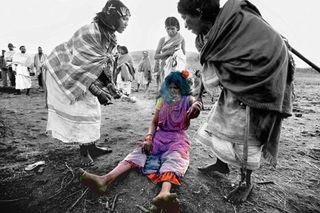
Reimagining Witchcraft as a Refuge for Marginalized Groups
Witchcraft continues to thrive and evolve, despite constant persecution and trivialization in popular culture.

More than four centuries ago, in 1566, a 40-something Agnes Waterhouse became the first woman to be executed for being a witch in Essex, England. Not much is documented from the time, but it is likely that Waterhouse — called “Mother Waterhouse” by the locals — was likely a single woman with a respectable position in society who was compassionate, helpful, wise and a healer.
What followed was the violent Catholic Inquisition (a group of institutions created to combat heresy, that is, any opinion or doctrine other than or contradictory to the Christian doctrine), which tortured and killed thousands of women in an effort to get them to confess that they could fly, turn into animals, and that they practiced black magic. In reality, they were simply independent women who practiced alternative spiritual practices and rituals that threatened the autocracy of the Church — “witches.”
Half a millennium later, thousands of women, including some from the Catholic church, are staging mass rituals to hex American Supreme Court Justice Brett Kavanaugh. Closer to home, Ipsita Roy Chakraverti, an Indian Wiccan priestess, has declared that every strong woman is a witch.
What is it about witchcraft, then, that has attracted so many women and arguably, even the LGBTQIA+ community, for centuries? Why does it continue to thrive and evolve, despite constant and bloodthirsty persecution and trivialization — or demonization — of its practitioners in popular culture?
Witchcraft inherently challenges the status quo
Throughout history, traditional and hierarchical religions like Christianity, Islam and arguably, even Hinduism (as it is practiced, not as it is preached in the Vedas and Upanishads) have put women in a subordinate position. Witchcraft, which is essentially the practice of paganism — a collection of eclectic indigenous beliefs dating back to medieval Europe, the Middle East, and Africa — and other forms of neo-paganism, has instead given refuge to women, and emboldened them to resist these hyper-masculine, God-in-the-image-of-man, male-dominated religions. These alternative spiritualities are therefore inherently subversive; they have always been against the status quo.
This can be seen in the myriad ways witchcraft mirrors religions like Christianity. Both have numerous traditions, practices, and beliefs, and long histories stretching back millennia. Both involve miracles or magic, depending on which side of the fence you’re on, and the belief there is something or someone bigger than humankind out there, which or who can be invoked through prayer or ritual.
In fact, the word “witch” comes from the Old English word Wicca, an ancient pagan tradition that reverses the masculine, feminine and earthly aspects of the Christian God in a not-so-authoritarian and hierarchical manner. While Christianity shames “deviant” sexuality, reserves religious leadership positions for men and gives them permission to “subdue” the Earth and “have dominion” over “every living thing” (Genesis 1:28), witchcraft believes all sexualities are natural and to be celebrated, that women are especially capable of being spiritual matriarchs and that nature is all-encompassing and sacred. “Witchcraft is especially interesting for lapsed Catholics who might miss the mysterious rituals of the church — the incense burning in a brass censer, the invocation of Christ’s body during communion — but can’t abide by its patriarchal structure, homophobia, and control and shaming of women’s bodies,” reports Alden Wicker in Quartz.
This space of reversal is also where the Church created mostly fictional concepts such as witches being Satan-worshippers — an over-simplification of the latter’s opposition to Christianity — that enabled their violent persecution. The insecurity at the heart of it all stems from the insecurity of the ‘feminine power’ which can be traced back to the very origins of witchcraft and Christianity.
Since ancient times, the clergy was in charge of healing the sick; one could even say, with seeming magic: through the transubstantiation of the Mass, magical cures from holy water and the power of relics of saints. Women, however, could not be priests simply because of their sex. But, the truth is, wise-women, or healers, and to a lesser extent, midwives predated the clergy. They have always existed with an inherent connection to herbology and medicine. In the pre-industrial era, “in rural areas of Europe, witches cured all descriptions of illnesses with herbs, poultices, prayers, and ointments.” The clergy saw them as a threat to their monopolistic power. Thus, it was during the Renaissance, and the consequent Inquisition, that the first coordinated efforts were made to remove the medicine from the realm of popular culture and establish it as the preserve of a restricted profession only to be practiced by men, specifically, priests.
A number of “strategies were then taken to eliminate women and other ‘popular’ healers from the medical ‘profession.’ One of these was the licensing of various practitioners. A second method was the prescription of university training – denied to women – for physicians. Another involved the accusation of witchcraft against irregular practitioners, such as ‘old wives,'” writes researcher Leigh Whaley in “The Wise-Woman as Healer: Popular Medicine, Witchcraft and Magic.”
The Church began a witch hunt, slandering these female healers with “anti-Christian” claims, not unlike the libel Jews have historically faced at the hands of the Church: witches ate babies, had sexual relationships with demons and used blood rituals as an offering to summon Satan. Most notably, a mean-spirited sexual pathology was at the heart of this “othering.” Witches were described as coming “from a carnal lust, which is in women, insatiable,” in Malleus Maleficarum, a book written by two Dominican monks in 1487. The book went on to become the touchpaper of the Inquisition’s torturous witch hunt, and its legacy is seen even today, when a powerful woman with agency over her sexuality is still seen as a threat to most patriarchal and capitalistic institutions.
In the Indian context — and some can lean on Orientalism and argue that India is one of the birthplaces of magic — Hinduism makes space for magic and witchcraft, as recorded in the Atharva Vedas, which consists of “mainly mantras used in witchcraft or sorcery, in the curing of diseases, for destruction of enemies, etc. They can be classified as the hymns, meant to secure [a] long life, get good wishes of the deities, ward off misfortune, pardon the misdeeds, obtain the kingship, as well as others. Similarly, these hymns also include charms to cure diseases and [faith-heal] wounds; imprecations against demons, sorcerers, and enemies […],” explains theologist A. Moniraj of the University of Hamburg. Additionally, concepts such as ghosts, sorcery, and witchcraft, fall under Tantra, a mystical text dating back to the 7th century A.D. or earlier. Adherence to Tantra includes chanting, meditation, yoga, and sexual practices; a Tantric believes that any human can acquire magical healing powers by channeling their sexual energy. When a woman does any of these things, she is known as a daayan or chudail, among several other names — all of them, pejorative.
Even though witchcraft finds mention in Hindu texts, “witch-hunting is most common among poor rural communities which have little access to education and health services, and longstanding beliefs in witchcraft,” writes Moniraj. According to the Indian National Crime Records Bureau, 2,097 people were murdered from 2000 to 2012 in the name of witch-hunting. Moniraj says it then becomes important to question how a woman is branded a witch: “If there is crop failure or if an individual gets sick or harm befalls the community, the blame falls not upon a virus or crop disease, but upon an alleged witch. Often a woman is branded as a witch so that she can be thrown out of the village and in order to grab her land or to settle scores, family rivalry, or because powerful men want to punish her for spurning their sexual advances.”
All in all, it came down to — as it usually does — sex.
Related on The Swaddle:
From Riches to Rags: The Evolution of Menstrual Taboos in India
Witchcraft is inherently queer
In witchcraft and neo-paganism, sexuality and gender have served as key sites for social and personal transformation and for revolt against the Christian and Muslim and Hindu idea that bodies and sex outside of marriage, and not for procreation, are sinful and dirty. Sexual freedom and diversity being mainstays of these alternative religions, LGBTQIA+ people and people who, for instance, practice polyamory, find a sense of community and spirituality in witchcraft that they don’t find in other religious spaces.
In her essay “Thinking Sex: Notes for a Radical Theory of the Politics of Sexuality,” anthropologist and theorist on sexuality and gender Gayle S. Rubin coins the term “the charmed circles,” referring to those sexualities, desires and practices that conform to society’s ideals: heterosexuality, monogamy, sex only for procreation, etc. Per Rubin, each one of these is matched with unacceptable counterparts, which fall outside the charmed circle — homosexuality, polyamory, kink, etc. — and are termed as ‘queer’ both by denigrators and by practitioners, as an act of reclaiming. This model of an ‘otherness’ can be extended to gender identities as well.
Misha Magdalene, who identifies as a queer, feminist witch, explains in their blog that witchcraft, neo-paganism, polytheist and occult movements are similarly “outside the charmed circle of culturally normative religious and spiritual identities, occupying an outsider status unavoidably similar to queer sexual and gender identities. What I suggest, in other words, is that magic, witchcraft, Paganism, and polytheism are queer […].” These forms of alternative spiritualities outside the charmed circle have historically embraced and incorporated both gender and sexuality queerness, as can be seen in osculum infame (kiss of shame), the witch’s supposed ritual greeting upon meeting the Devil, which includes kissing his anus; or in the genderqueerness of Dionysus (Greek God of wine, fertility and ritual madness). English Wiccan Doreen Valiente, who was born in the 1920s, wrote “all acts of love and pleasure are my rituals” in one her many poems, which were later uncovered and published in the book Charge of the Goddess.
“When I say that witchcraft is queer, I mean that it exists outside the charmed circle of spiritual [practice] in our culture, but beyond that, I mean that queerness of sexuality and gender are intrinsic to the [knowledge] and [practice] of witchcraft,” explains Magdalene.
Witchcraft continues to thrive by reimagination
So, witchcraft has historically been non-normative, empowering and inclusive of all those excluded by mainstream religions, which also explains its feminist resurgence in the 20th and 21st centuries.
The resurgence of witchcraft began in the late 1960s and 1970s, on the eve of second-wave feminism and sexual liberation. Writing “On the Trail of the ‘Witches’: Wise Women, Midwives and the European Witch Hunts” in 1986, researchers Ritta and Richard Horsley explain that in moving away from earlier analyses that focused on the persecution of alleged witches as a violent manifestation of Western male culture’s fear and hatred of women, some feminists began following a more romantic theorythat viewed witches as “members of a pagan fertility religion, an underground survival of a prepatriarchal, nature- and woman-centered culture. … feminist witchcraft has reclaimed the figure of the witch as a symbol of suppressed female knowledge, power, and independence.”
This idea of witchcraft has peaked and troughed since then, but with feminism in the mainstream again; with sexualities, gender identities and relationship norms being accepted as existing on a spectrum; and with social media providing an easy way to find alternative communities — witchcraft is back, reimagined and ever-expanding to include all those the “inner charmed circle” excludes. The New York Times notes that this is happening “at a time when misogyny is rampant and women’s rights are on shaky ground.”
“Modern witchcraft is a movement that is being propelled out of the forest and into the mainstream. The hook-nosed, broom-riding, pointy-hat-wearing, cackling witches of yore have transfigured into hip, feminist, millennial women with slick websites and soothing advice on manifesting your dreams. Instead of a bubbling cauldron filled with eye of the newt, they’re slinging essential oils seeped with wild herbs,” writes Wicker in Quartz. Complete with spell-casting covens waiting to be found on Meetup, hashtags such as #witchesofinstagram and witch influencer, stores selling healing crystals, tarot cards and spell-kits, “mysticore” has been termed as the new norm by K-Hole, a trend-forecasting firm.
Today, it is easy to see the many ways in which modern witchcraft and feminism intersect: both ‘witch’ and ‘feminist’ are radical personal identities, inescapably politically charged with the belief that every person (and creature, plant) has a spirit to it, which must be respected.
“The witch as an icon is resonating right now because we’ve entered a fourth wave of feminism,” said Pam Grossman, author of What Is a Witch and co-founder of the Occult Humanities Conference at New York University, while speaking to Salon. “We are redefining what power, leadership, beauty, and value look like on our own terms. And the witch is the ultimate symbol of female power. Doing witchcraft is a way to connect to that energy, which is so needed right now, as we’re beginning to collectively course-correct thousands of years of sexism and oppression.”
Today, anyone can be a witch. From the tarot-card-pulling, spell-casting witch, to more serious practitioners who train for decades before starting their own covens, to practitioners of Wicca (a subset of witchcraft with specific gods, goddesses, symbols, and rituals), witchcraft today exists on a — you guessed it: spectrum. “The edges of this group also bleed into other more mainstream arenas such as yoga and meditation, mindfulness, new-age spirituality, and even sex-positivity,” writes Wicker. The ‘Tumblr Witch’ exists at these edges: the politically aware, intersectional feminist who redefines the cultural and historic identity of the satanic witch with irreverence (and a heavy dose of hipster consumerism).
“We see ourselves as continuing a long line of unruly women,” says Jaya Saxena, co-author of Basic Witches, with Jess Zimmerman. Neither of the two women are Wiccan or pagan. In fact, in an interview, Zimmerman confesses she’s an atheist who doesn’t believe in the occult or mysticism.
Closer to home, Ipsita Roya Chakraverti (a practicing Witch) is propounding a similar brand of witchcraft believing “Wicca and witchcraft [are] the keys to liberation“: “India is very patriarchal, even today. When they saw me, standing up for those they were trying to brand and destroy, and saw that I was helping these women by calling myself a ‘witch,’ these lobbies erupted with fury. These were vested interests that could not tolerate me because I was saying that a woman who was an individual had her own rights,” she said in a 2015 interview. In 1994, she told a Delhi MidDay reporter, “I want to awaken the witch in every woman.” By her estimation, there are more than 5000 practicing Wiccans across India; Moniraj estimates that close to 130 tribal communities in the North East, particularly in Assam, still follow some form of paganism.
It’s not just women who are finding witchcraft appealing. Among those in the LGBTQIA+ community, being a witch is becoming increasingly more popular, according to VICE: “It’s deeply appropriate that shows such as Charmed and The Chilling Adventures of Sabrina are featuring queer people front and center as main characters handling their own struggles through supernatural means and alongside magic and witchcraft.”
Related on The Swaddle:
Netflix’s ‘Sabrina’ is Not the Woke Feminist Show It Thinks It Is
Speaking to VICE for the above story, Colby Gaudetsays identifying as a witch appeals to their “self-professed, strange exhibitionist quality by playing with people’s preconceived notions of tattoos, of their non-binary gender identity, and of how a witch should look.” When Gaudet first discovered witchcraft as a teenager, its message of self-acceptance and personal expression allowed them to explore a queer identity in a shame-free space. When they encountered the male-female binary even in witchcraft, they simply expanded it by meeting other queer witches who introduced them to more subversive practices. “The capacity for witchcraft to accommodate alternative expressions of gender is what makes it appealing to a new generation of witches,” concludes Gaudet.
Witchcraft is also inclusive of young adults, who approach religion and spirituality differently than older generations do. Millennials, for instance, are increasingly identifying as “nones,” that is, no religious affiliation, according to a 2017 Pew survey. They are atheist or agnostic, or “spiritual but not religious.”
The increase in ostensibly over-the-top portrayals of witchcraft — think Charmed, Buffy the Vampire Slayer or Netflix’s Chilling Adventures of Sabrina (the teenage witch) — has exposed new generations to these alternative communities. In Teenage Witches: Magical Youth and the Search for Self, researchers Helen A. Berger and Douglas Ezzy find these youths to be “deeply involved in the spiritual and self-growth aspects of witchcraft and only secondarily interested in instrumental magic.” For them, witchcraft is a source of empowerment that draws them into “individualistic self-discovery or self-reflexivity … central to contemporary culture … (and also) it is non-dogmatic and [lacking] a central hierarchy.”
Bottom line: witches are alive, and well, and fighting against the patriarchy and heteronormativity that encourage sexism, racism, homophobia, and transphobia. Magdalene explains that witchcraft — of the past and present — is intrinsically non-normative: “it stands in isolation from, or in opposition to, the norms of whatever culture in which it arises.” For that reason alone, witchcraft is here to stay, proudly owning the pejorative name it was first assigned.
Correction: An earlier version of this article incorrectly spelled Misha Magdalene’s first name as ‘Mida’ and used female pronouns to refer to them. It has been updated to reflect the correct spelling of their name and their preferred pronouns.
Pallavi Prasad is The Swaddle's Features Editor. When she isn't fighting for gender justice and being righteous, you can find her dabbling in street and sports photography, reading philosophy, drowning in green tea, and procrastinating on doing the dishes.
Related


Controversial Crush: Jameela Jamil and Her Brand of Body Positivity
